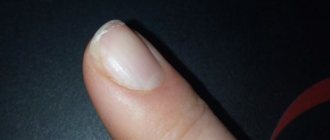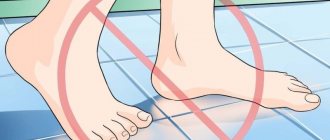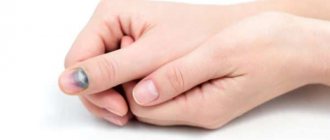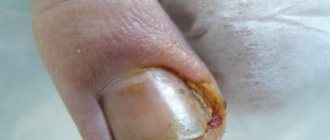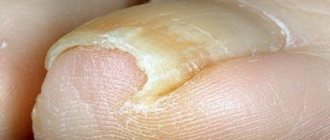Causes
Cracks in toenails appear due to the destruction of the nail plate, which consists of horny tissue. A healthy plate is quite strong; such a structure is necessary to perform the function of protecting the nail bed, in the area of which the nerve endings are concentrated.
Under the influence of certain provoking factors, toenails crack lengthwise, which threatens to aggravate the pathology or cause a secondary infection.
Pathological conditions in which brittle toenails grow are very common, but there are situations when healthy plates also crack:
- Mechanical damage as a result of injury: the nail cracks in the middle after an impact or as a result of a fall. In this case, healthy tissue can also be damaged; dissection occurs with a strong blow or impact with a sharp object.
- Infection with a fungal infection that parasitizes the nails, making them soft and vulnerable. If the nail begins to break and the color of the nail plate changes from pink to yellow or black, then it is most likely that the patient has become infected with a fungus, which is a very contagious disease.
Why do toenails break when exposed to fungus? The horny tissue acquires a porous structure and becomes brittle. Vertical cracks can form on the affected finger without external influence.
- Lack of vitamins, minerals and calcium in the body affects nails and hair. Brittle nails are caused by a deficiency of substances that make the nail plate not strong enough and grooves appear along the plate. This explains why nails crack.
- In older women, one of the signs of hormonal changes in the body is if nails break. A decrease in progesterone production negatively affects dry skin, nails and hair. The causes and treatment in women come down to individual selection and prescription of missing hormones and taking special vitamin complexes that replenish the deficient state.
- If your nail is cracked, it may be due to a trivial reason - wearing shoes that don't fit properly or tight shoes in the nose area. Damage will appear after mechanical friction of the nail against the material from which the shoes are made.
- Diseases with metabolic disorders or autoimmune pathologies can be the cause if the nail is cracked.
- Why do nails break in childhood? There are several reasons here:
- a decrease in the number of red blood cells in the blood, leading to insufficient supply of oxygen and nutrients to the cells;
- mental disorders in children;
- disruption of metabolic processes and biochemical reactions;
- abnormalities in the functioning of the adrenal glands.
Repair
It will not be difficult to cope with plate deformations at home. All you need to use is clear varnish, a napkin, and a nail file. You need to use a nail file to go over the damaged plate, then brush off the dust. Apply a layer of clear varnish and let it dry. After spreading the napkin over the nail, apply the polish on top again and leave it to dry. After this, it is recommended to contact specialists if this method turns out to be useless. In cases where your toenails crack and blood is visible, you should not self-medicate. This is an indication for a serious examination.
Diagnostics
In order to figure out why your nail is cracked in the middle, you need to consult a medical specialist who deals with similar problems. The doctor will be able to differentiate the pathology, prescribe tests and conduct a visual examination.
To establish the exact cause, you need to conduct a series of tests:
- laboratory testing of blood and urine;
- cytological examination of part of the cracked nail.
After receiving the results, an additional consultation with a mycologist, endocrinologist, rheumatologist, or dermatologist may be prescribed.
After a personal examination and medical history, the doctor will be able to suggest the cause of brittle nails; only after receiving the results of each examination, the doctor will be able to approve a preliminary diagnosis and prescribe effective treatment.
Treatment
Therapeutic measures for damaged nail plates are limited not only to external procedures; internal treatment with tablets and vitamin complexes is included in the therapeutic complex.
The selection of drugs and treatment regimens should be carried out by a qualified doctor; self-medication is not allowed; incorrect actions can lead to undesirable consequences, including blood poisoning.
Injuries
A longitudinal crack in the nail after a traumatic impact is treated with timely dressings and compliance with antiseptic rules when in contact with the wound. Dirty hands or untreated tools can cause suppuration in the area of the crack, which can lead to complete loss of the nail plate.
First aid
What to do if the nail on your big toe cracks during a bruise:
- treat the wound with hydrogen peroxide or an aqueous solution of chlorhexidine;
- if bleeding occurs, apply a pressure bandage; if the blood does not flow much, the wound can be sealed with a plaster;
- a cold object should be applied to the injured finger to prevent swelling and reduce the appearance of hematoma;
- go to a trauma center to rule out the possibility of a fracture.
If the wound is shallow, the finger will heal quickly, but the nail plate itself will not grow together. Over a long period of time, the nail grows with a healthy structure, and the cracked part needs to be cut off. When the nail plate grows, it will cover the damaged area on the finger and there will be no visible signs of the previous injury.
Fungus
A crack in the toenail as a result of onychomycosis is a common occurrence. Fungal infections are an insidious disease that is difficult to treat.
The pathology is prone to relapse, therefore, the mistake of many people is to stop using antifungal solutions or varnishes after a healthy nail has grown out. Fungal spores can be dormant, therefore, after an imaginary recovery, the nail suffers again.
Therapy consists of treating the infected nail plate with medicinal forms intended for the treatment of nails. Before treatment, the leg must be washed with laundry soap, and the skin of the finger must be lubricated with onychomycosis cream.
The patient’s shoes are treated every day with special solutions that kill the pathogen. Household slippers and personal hygiene items should only be used by patients.
How to save nails from fungus? You need to be patient for a long treatment. If the nail is cracked lengthwise, it will most likely be removed, and a beautiful, healthy nail plate will grow in its place. At this moment, the main thing is not to stop the procedures and continue the preventive course.
Avitaminosis
For the proper formation of tissues in humans, it is important to supply a sufficient amount of microelements and vitamins to provide cells with “building material”. A deficiency condition leads to external manifestations, including on the nails.
Treatment consists of selecting a complex of vitamins with the missing elements. Only a medical specialist who has previously conducted laboratory blood tests can choose the right treatment complex.
Climax
The processes associated with the cessation of menstruation occur against the background of hormonal imbalance in the female body. Therapy is developed strictly individually, taking into account all the features of a particular case.
Products containing the missing hormone are prescribed; the cracked nail plate does not need to be masked; it is allowed to be covered with a protective strengthening coating in the form of varnish.
Cracks in children
If a child's toenails are cracking, parents need to pay close attention to this sign. Once you know the reason, you need to follow the doctor's recommendations to remove the reason why your nails are cracking.
Treatment of pathologies is carried out both local and general. In severe cases, the baby may be admitted to a hospital for examination and therapeutic procedures.
Cracks in toenails: causes, treatment methods and prevention
Experts tend to consider a person’s nails as a kind of indicator by which one can judge the state of the body.
Cracks in toenails are evidence of pathological processes that cannot be ignored. Immediate consultation with a doctor and proper treatment can avoid the development of unpleasant and even dangerous consequences.
Causes of crack formation
Experts divide cracks in the nail plate into two types:
Regardless of the type, violations of the integrity of the nails on the fingers of the lower extremities have common causes. Conventionally, they are divided into two groups - external and internal.
External reasons
The appearance of cracks in the toenails is provoked by factors of external origin, for example, mechanical stress. Weakened nails that are prone to splitting are particularly affected. Increased stress leads to the fact that the nail begins to break off and crack.
Long-term contact with household chemicals, which include chlorine and its derivatives, can be called the cause of the development of pathology. It is a mistake to believe that only the fingernails suffer. When washing floors, splashes of water can fall on the surface of the feet and destroy the nail plate.
Attention! People who professionally engage in wet cleaning of premises using household chemicals are recommended to wear closed, waterproof shoes.
Cracking and delamination, and therefore the formation of cracks, are provoked by poor-quality pedicure. Some inexperienced nail technicians make mistakes in nail processing technology, which leads to pathology.
Internal reasons
Internal factors include diseases of an infectious nature. Cracks in the big toe nail often occur due to psoriasis, eczema or fungal infection.
Important! A lack of minerals and vitamins negatively affects the condition of the nail plate, which becomes susceptible to injury and begins to peel and crumble. All this makes it possible for cracks to appear.
Particularly often, nail separation due to a lack of vitamins is diagnosed in a child in the active growth phase. Nails that are actively gaining length are easily injured, which due to a lack of calcium leads to delamination.
Parents should trim their child's nails regularly to minimize the chance of damage. You should review your diet, saturating the menu with healthy foods. Children over two years old who have a cracked nail plate must be shown to a pediatrician.
Treatment options
Cracked nails should definitely be treated. The choice of tactics is determined by the degree of damage and the cause.
Home option
It often happens that while doing housework, the nail plate of the thumb is injured. If the degree of damage is insignificant, you can limit yourself in this way:
- Carefully sand the surface of the damaged nail with a nail file.
- Coat the smooth surface with varnish (preferably colorless).
- When the first layer is completely dry, stick a small piece of silk onto the nail with medical glue (can be replaced with a paper napkin).
- After the glue has dried, remove excess fabric, then cover the entire surface first with another layer of glue, and after sanding with varnish.
It is advisable to keep such “repairs” for no longer than a day. After this time, you should contact a pedicurist who will perform professional treatment of the nail plates.
Treatment of cracks with pharmaceutical products
You should resort to pharmaceutical remedies if internal provoking factors lead to cracking of nails. If the cause is a skin disease or fungal infection, you should consult a dermatologist or mycologist for additional advice. The specialist will prescribe additional studies.
A fungal infection can only be cured if the pathogen is eliminated. Drugs are prescribed that have a local, targeted effect on the fungus. To protect the surface from further injury, it is recommended to coat it with a protective varnish with an antifungal effect.
If the cause of the cracks is nail dystrophy, the patient is prescribed a complex of vitamins and microelements. At the same time, you can use traditional medicine recipes.
Folk remedies for treating cracks
Traditional medicine recipes are an addition to the main course of treatment, helping to achieve a lasting effect.
Baths
One of the simplest and most affordable options is a salt bath. You will need 2 tbsp. l. Dissolve salts in warm water and immerse your feet in the resulting solution. The procedure time is 15 minutes.
Something to remember! If the crack is deep and extensive, the use of a salt bath is contraindicated as it can cause severe pain.
Another option is an oil bath. In a bowl of warm water, add oil solutions of vitamin E and A in equal parts (a teaspoon), 2 tbsp. l oil (olive, castor). Mix thoroughly and immerse your feet for 20 minutes.
Lotions and compresses
To treat cracked nails, it is effective to use aloe compresses. The pulp of the plant is placed on the surface of the damaged nail and fixed with a bandage or adhesive plaster. The compress is left overnight. Repeat every evening until the crack heals completely.
Ointments
They can be applied not only to the nail, but also along the plate to further saturate the surrounding tissue with useful substances.
For cracks, an ointment made from one yolk, a tablespoon of vegetable oil and a teaspoon of vinegar helps well. The components are thoroughly mixed, after which the resulting mass is lubricated on damaged nails.
You can make an ointment from melted butter mixed with honey. The resulting mixture is applied several times a day. The possibility of an allergic reaction should be excluded.
How to treat “diabetic” fissures
People diagnosed with diabetes of any type suffer from reduced immunity. This leads to the fact that minor but regular cuts and systemic circulatory disorders become the cause of the development of fungal nail infections. Because of the fungus, nails quickly change color, peel and separate.
Treatment of the condition with diagnosed diabetes mellitus is extremely difficult. This is explained by the fact that many drugs are contraindicated for this disease.
All medications are selected taking into account the following requirements:
- There is no incompatibility between drugs for diabetes mellitus and drugs with an antifungal spectrum of action.
- The patient does not experience a sharp drop in glucose levels.
- The drug has no contraindications that could negatively affect the health of a diabetic.
Important! Any medications for diabetics, including antifungals, are prescribed on an individual basis.
Folk recipes
The experience of ancient healers will help restore damaged nail plates:
- A mask made of honey, glycerin and starch will provide a healing and anti-inflammatory effect. All components are taken in equal proportions and mixed. The healing mixture is applied in a thick layer to the crack and kept for no more than ten minutes, after which it is washed off with cool water.
- Beeswax is known for its antibacterial and regenerative properties. You need to cook the drug over low heat. To do this you will need five grams of beeswax, thirty milliliters of olive oil and chamomile decoction. The mixture is heated until completely dissolved, then cooled. Apply for fifteen minutes no more than twice in seven days.
- Celandine is crushed and mixed with distilled water, adding small quantities of calendula and oregano juice. This composition should approach the consistency of an ointment. The medicine should be applied to the cracked nail three times a day until the damage heals.
- To treat onychomycosis, apple cider vinegar is used: vinegar is poured into warm water in equal quantities and the affected limbs are immersed for seven minutes, after which they are washed and dried with a towel. Vinegar has an antifungal and restorative effect; you can use this method once a day.
- Treatment with horsetail will help significantly strengthen the nail plates due to the large amount of silicon it contains. A healing solution is prepared for a foot bath: ten grams of horsetail is poured with water (200 ml) and left to infuse for ten minutes. After cooling, the broth is poured into a container and the sore limbs are dipped for thirty minutes. After the procedure, you can lubricate the nail with olive oil.
Diseases
Brittle nails are caused by a deficiency of vitamins A, D and E, most often this occurs in winter or early spring due to vitamin deficiency.
READ ALSO: Scholz file: why is it used, how to use it and where to buy?
An unhealthy or unbalanced diet can cause a lack of calcium, magnesium, zinc and potassium, which make up the nails. This makes them too soft and susceptible to mechanical stress.
Sometimes there are enough minerals and vitamins, but they are not absorbed. This serves as an indicator of problems with the thyroid or pancreas, liver. But don’t panic - nails are just one of the symptoms, and in the case of diseases of these organs, you would have identified them even before problems with nails.
Complications
If you carelessly care for the wound under a cracked nail, inflammation may begin with the introduction of a purulent infection. The finger begins to swell and becomes hot to the touch, while the pain is intense and throbbing. Pus appears at the site of infection, which requires immediate surgical intervention.
In addition to local infection, the pathogen can enter the bloodstream, causing general intoxication. Sepsis develops rapidly, affecting the entire body. If you do not respond to the pathology in time, a sad outcome is possible.
An advanced fungal infection can destroy all nails and spread to the skin and hair. In this case, the treatment will have to be carried out for years, and the restoration of diseased nail plates will take even longer.
Prevention
To keep your nails healthy and your nail plates from cracking in half, you need to eat right and take a preventative course of vitamins. When the first signs of external changes or unpleasant general symptoms appear, it is important to be treated for pathologies in a timely manner.
In addition, it is useful to strengthen nails using simple recipes:
- Foot baths with the addition of olive oil will strengthen the stratum corneum that covers the nail plate. The procedure can be applied every day for seven days.
- Vitamin E and A in solutions can be bought at a pharmacy without a doctor's prescription. Lubricate your nails with vitamins every day, one at a time. You need to do alternate applications for eight days, after which it is recommended to let your nails rest for a week.
- Sea salt has a good strengthening effect, while simultaneously saturating the nails with microelements. To prepare the solution, prepare five grams of salt and a glass of water, combine the components and immerse your hands or feet for fifteen minutes. After the bath, wipe the skin and nails dry.
Tags: fungus, nail, nails, foot About the author: Andrey Stepanovich
« Previous entry
